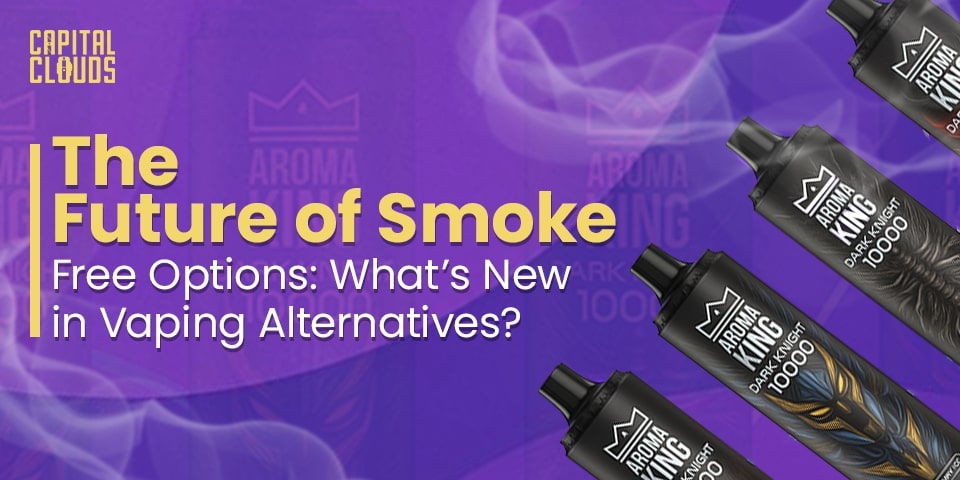The Future of Smoke-Free Options: What’s New in Vaping Alternatives?

In the past decade, the landscape of smoking has undergone a dramatic transformation. Once dominated by traditional cigarettes, the market has evolved to accommodate a wide range of smoke-free alternatives that not only aim to reduce health risks but also cater to shifting consumer values around wellness, technology, and sustainability.
The decline of cigarette smoking has been accelerated by growing public health awareness, stricter regulations, and technological innovations. In its place, vaping and other nicotine alternatives have risen, offering new possibilities for smokers seeking to quit or reduce harm. But as we look ahead, it’s clear that the world of smoke-free living is expanding beyond traditional e-cigarettes. From nicotine-free options to herbal innovations and smart devices, let’s explore the exciting future of vaping and the next generation of smoke-free alternatives.
1. The Evolving Role of Vaping in Smoke-Free Lifestyles
Vaping was initially introduced as a safer alternative to smoking, offering nicotine delivery without the harmful by-products of combustion. While studies are ongoing, public health bodies like Public Health England have acknowledged that vaping is significantly less harmful than smoking. As a result, millions of people worldwide have turned to vaping to reduce or eliminate their cigarette use.
However, the vaping industry has evolved rapidly. What was once a niche solution is now a global trend, with diverse products designed to suit different preferences—from cloud chasers and flavour enthusiasts to discreet, minimalist pod systems. Today’s vapes are sleeker, smarter, and safer than ever before. But even more exciting is how the industry is branching out to include more innovative, personalised, and wellness-oriented solutions.
2. The Rise of Nicotine-Free Vaping Products
One of the most promising developments in the world of vaping is the growing popularity of nicotine-free vape products. These options are tailored for individuals who enjoy the sensory and behavioural aspects of vaping—such as the hand-to-mouth action and flavour experience—without the addictive substance.
Nicotine-free vapes are especially popular among:
- Former smokers who have already weaned off nicotine but still enjoy the act of vaping
- Health-conscious individuals who want a cleaner alternative
- Social vapers looking for a casual, non-addictive experience
These products come in a vast range of flavours—from fruity to dessert-inspired—ensuring users can enjoy vaping without compromising on taste or satisfaction. As the wellness industry continues to grow, nicotine-free options are expected to become a major force in the vape market.
3. Heat-Not-Burn Technology: A Safer Tobacco Experience
Heat-not-burn (HNB) devices represent a fascinating middle ground between smoking and vaping. Rather than combusting tobacco, these devices heat it to a controlled temperature, releasing a flavoured vapour with fewer toxic chemicals than traditional smoke.
Unlike e-liquids used in standard vapes, HNB products still use real tobacco. However, because they do not involve burning, they avoid many of the harmful by-products associated with combustion, such as tar and carbon monoxide. Popular examples include IQOS by Philip Morris and glo by BAT, both of which have seen substantial adoption in parts of Europe and Asia.
For smokers who are not ready to switch to e-liquids or entirely quit tobacco, HNB provides a potentially less harmful stepping stone. The future may see more hybrid devices that bridge the gap between vaping and HNB, giving consumers more flexible choices on their smoke-free journey.
4. CBD and Cannabinoid Vaping: Therapeutic Smoke-Free Options
The integration of CBD (cannabidiol) into vape products is another major trend reshaping the industry. Derived from the hemp plant, CBD is non-psychoactive and widely used for its potential therapeutic benefits, including anxiety relief, pain management, and improved sleep quality.
CBD vape pens and cartridges are now widely available, offering consumers a fast-acting and convenient way to experience the effects of cannabinoids. These products typically contain no nicotine, making them ideal for wellness users rather than ex-smokers.
The future may also bring:
- Custom cannabinoid blends designed for specific health outcomes (e.g., relaxation, energy, focus)
- THC-free formulations with verified lab results for added safety
- Regulation-backed CBD products that meet medical-grade standards
As public understanding and legislation around cannabis continue to evolve, the role of cannabinoids in smoke-free alternatives will likely expand even further.
5. Herbal and Botanical Vaping: Nature-Inspired Alternatives
As wellness and holistic health continue to influence consumer trends, herbal and botanical vaping is emerging as a compelling alternative for those seeking a natural smoke-free experience.
These products typically contain:
- Dried herbs like chamomile, lavender, peppermint, or green tea
- Natural terpenes for flavour and aroma
- No nicotine or synthetic ingredients
Herbal vapes are gaining popularity among users who want a calming, therapeutic experience without exposure to harmful chemicals or addictive substances. They’re often used for stress relief, meditation, and bedtime routines.
Looking ahead, we may see more herbal vape blends tailored to specific health needs, such as respiratory support, immune boosting, or mood enhancement. These natural alternatives offer an exciting glimpse into how vaping can align more closely with a wellness-focused lifestyle.
6. Smart Vape Technology: The Digital Transformation
Like many modern devices, vaping is entering the age of smart technology. Smart vapes incorporate features such as:
- Bluetooth connectivity with mobile apps
- Real-time puff tracking and usage analytics
- Temperature and wattage control
- Safety alerts and usage limits
These advancements allow users to personalise their vaping experience while improving safety and consistency. For instance, some smart vapes let you track your nicotine intake or set daily usage goals—perfect for those trying to gradually taper off their usage.
In the future, expect to see AI-powered vape assistants, integration with health tracking apps, and even biometric feedback to help optimise your vaping routine. This convergence of technology and health is poised to redefine how we approach nicotine and wellness products.
7. Eco-Friendly Vaping: Towards a Sustainable Future
As environmental awareness grows, so too does the demand for sustainable vaping products. Disposables and plastic-heavy designs have come under scrutiny for their environmental impact. In response, many companies are developing:
- Refillable and rechargeable devices that reduce waste
- Biodegradable components and recyclable packaging
- Green e-liquid manufacturing using natural ingredients
Sustainability is not just a trend—it’s a necessity. The future of vaping will likely involve tighter regulations around waste and eco-conscious innovation at every stage of the supply chain. Brands that prioritise the planet while delivering high-quality experiences will lead the next wave of smoke-free products.
8. Regulatory Developments: A More Responsible Industry
Regulation plays a crucial role in shaping the future of smoke-free alternatives. In recent years, governments worldwide have taken steps to ensure the safety, quality, and marketing of vaping products. This includes:
- Age restrictions and sales bans to minors
- Ingredient transparency and labelling
- Restrictions on advertising and flavouring (especially to protect young users)
Moving forward, we can expect even more evidence-based regulation, promoting harm reduction while preventing misuse. Legitimate vape brands that comply with these evolving standards will have greater trust among consumers and health professionals alike.
Conclusion: The Smoke-Free Future Is Bright and Diverse
As we look to the future, one thing is clear: the world of smoke-free alternatives is rapidly expanding. Whether you’re someone trying to quit smoking, reduce harm, or simply explore a healthier lifestyle, the options available today—and those coming tomorrow—offer more variety, control, and peace of mind than ever before.
From nicotine-free vapes and herbal blends to CBD pens and smart devices, the next generation of smoke-free living is about personalisation, wellness, and sustainability. As technology and research continue to evolve, consumers can look forward to a future where smoking is not only less harmful—but potentially obsolete altogether.
 Help Center
Help Center




